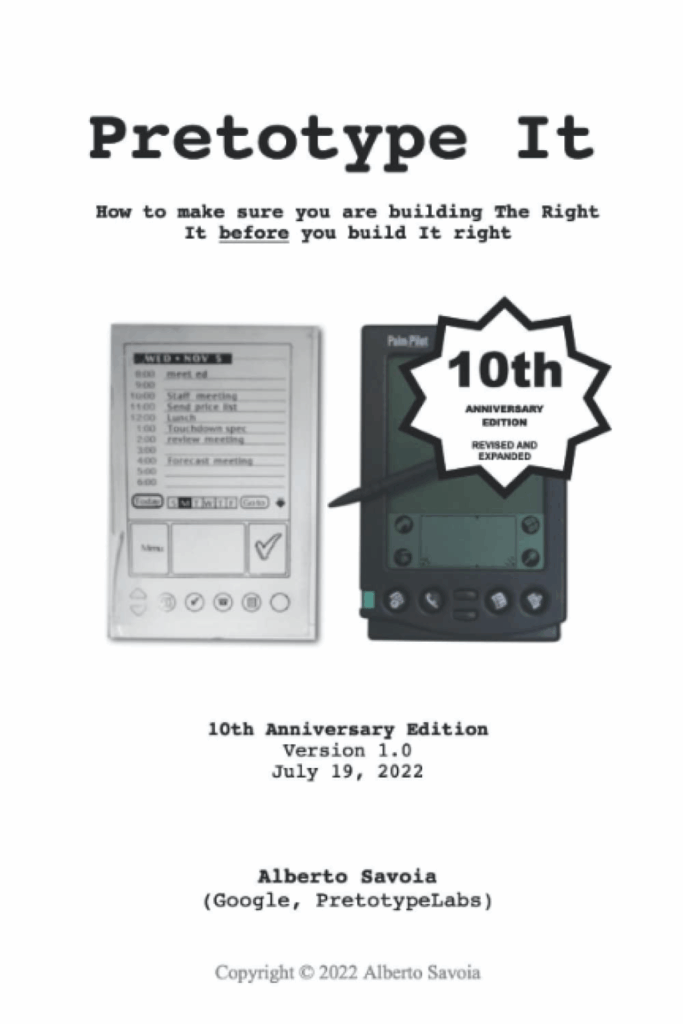Table of Contents
TL;DR – Pretotyping: Fake it Before You Make it
Pretotyping is the art of testing product ideas before investing in full development. It’s about answering the most critical question first:
Would anyone actually use this if it existed?
“Pretotyping is an approach to developing and launching innovation that helps you to determine if you are building the right it before you invest a lot of time and effort to build it right. Pretotyping helps you to fail … but fast enough and cheaply enough that you have time and resources to try something different.”
Key takeaways:
- Don’t build the product—simulate it. Use videos, landing pages, manual workflows or paper mockups to validate demand.
- Focus on behavior, not opinions. What people do matters more than what they say.
- Successful Pretotyping examples include Dropbox’s explainer video, Zappos’s manual shoe delivery, and Groupon’s WordPress blog.
- It helps reduce risk, avoid waste, and build only what truly matters.
Pretotyping is a mindset: Think big, start fake, learn fast.
What’s the deal with Pretotyping?
The term ‘Pretotyping’ and its concept were created by Alberto Savoia in 2009. He was Director of Engineering and ‘Innovation Agitator’ at Google, where he oversaw the development and launch of Google AdWords.
“Pretotyping is an approach to developing and launching innovation that helps you to determine if you are building the right it before you invest a lot of time and effort to build it right. Pretotyping helps you to fail … but fast enough and cheaply enough that you have time and resources to try something different.”
(Pretotyping Blogspot)
Or to put it more bluntly: Ensure that you are developing the correct product concept before perfecting its execution. The key is to ascertain as early as possible whether a product idea indeed possesses the assumed market viability, thereby mitigating substantial financial risk for the company. There are plenty of examples to illustrate this point:
- Dropbox: Before writing a single line of code, Dropbox released a simple video explaining the concept of file sharing. The goal? To see whether the potential product resonated with users at all.
- Zappos: To test whether people were willing to buy shoes online, Zappos uploaded product photos from local shoe stores to a basic online shop. When someone placed an order, the team would buy the shoes at the physical store and ship them to the customer.
- Groupon: Groupon started with nothing more than a basic WordPress blog to test whether people were interested in buying vouchers online. Every purchased voucher was manually turned into a PDF and sent via email.
In one of my posts, I discussed the concept of the ‘Ugly Baby’, which often occurs when new products are revealed too late, usually when it’s impossible to turn back. During the presentation mentioned above, a light bulb moment happened, and I instantly recalled several real-world examples.
Case studies
Pretotyping – case study 1: Yet we tested it!
I was responsible as a product manager for integrating two successful platforms with a large reach. The goal was to offer sellers in a high-priced product segment the opportunity to increase the reach of their active listings by incorporating them into the other (transaction-based) platform.
The assumption was that this would create significant value for both sellers on the listings platform and potential buyers on the transaction platform, thereby reaching new target audiences and being able to charge additional fees for the feature.
The potential complexity posed challenges and risks:
On the one hand, whether users (buyers), based on their learned behaviour, actually understand and accept a search results page that includes different formats (transactional and advertising formats).
On the other hand, from a technical perspective—starting with APIs, through listing and editing offers, to the logic behind displaying results in the search experience—not to mention country-specific nuances and cross-border scenarios.
After an initial assessment, the complexity was estimated to cost several hundred thousand euros in pure development or development-related expenses. This naturally resulted in a significantly higher total value. When factoring in the efforts associated with a project, including coordination, communication, and marketing, the total quickly reaches the single-digit million range.
“The underlying business case did not come close to materialising.”
The project ran for nearly a year from the initial concept phase to the completion of the refinements. The outcome? After a few months, the project was discontinued in its core and primary market. The underlying business case did not come close to materialising. On the contrary, the feature even jeopardized the original transaction model in the affected product segment.
What had occurred? Was the technical execution poor? Did the marketing fail? Was the user interface not tailored to buyers’ needs? Did we lack the necessary persistence? No, none of that. Put simply, the concept was incorrect, completely missing the market’s needs, and should never have been rolled out in this way.
But why did it take us so long to realise this? We engaged with over ten potential users (buyers) beforehand to gauge their acceptance of the idea of an additional format, and the response was mostly positive.
Furthermore, we dedicated two weeks to calculating a well-founded business case. Most importantly, during the development of the specification, we tested several prototypes (Click Dummies) in multiple countries, spending at least €30,000, to identify early on which presentation works best for users on the search results and product pages with the ad format…
The way the idea’s failure was handled proved to be the most perplexing aspect of the situation. Long after, the project’s proponents staunchly defended it (partly due to its technical quality…) instead of critically evaluating its market value and, more crucially, the approach to future product development. Even at the management level, the project and its ‘failure’ were largely ignored.
Pretotyping – case study 2: boosting shop owners
In my role as a Product Owner, I was responsible for a specific business area of an (international) platform. Users could run their own online shops in a hosted scenario and sell products on a commission basis. The project aimed to quickly increase the activity of newly registered shop owners. The solution involved introducing ‘activation emails’ to motivate and support users in completing the setup of their shops and listing their first products.
The project for the major target markets took about five weeks to complete, including the planning phase, plus revisions and expansions. With an average of two backend developers, one designer, one tester, two marketing experts for concept and tracking/reporting, and a product owner, it’s easy to calculate the direct and indirect costs involved.
The complexity on the technical side was in the logic of the sending time and frequency, depending on the user profile. Initially, this was done with maximum flexibility to easily adjust the rules at any time.
“Similar to Case Study 1, the authorities unfortunately rejected a fundamental questioning of the idea.”
Initially sounding very valid and suggestive of a professional execution. The impact and hence the economic benefit? None. Upon analysis, we found that the feature had no discernible effects on the shop owners’ activity. Similar to Case Study 1, the authorities unfortunately rejected a fundamental questioning of the idea here as well. Instead, the project was positively assessed from the perspective of new technical infrastructure, as it would have laid a foundation for future similar requirements.
The point at which the ‘Ugly Baby’ could have been eliminated had already long passed by this stage. Instead, it was carried forward and nourished with refinements and fresh concept ideas.
Afterwards, one is wiser… or perhaps not
Does this sound familiar to you? What are the recurring major mistakes made in large projects?
- Solution-first instead of problem-first approach:
The team was handed a predefined solution instead of jointly analyzing the problem and its root cause. As a result, the team was not given the opportunity to find the right solution themselves. - Decisions based on assumptions:
A business case should primarily serve to explore goals, constraints, and potential outcomes as early as possible. However, even a detailed business case often contains too many critical unknowns (and too much wishful thinking) to justify a fully developed product at such an early stage. - Lack of self-reflection in leadership:
In many companies, “failure” is still equated with loss of face. Leaders push through their ideas at all costs—often as a misguided expression of strength—rather than fostering a culture of critical thinking and learning. This is frequently reinforced by a lack of subject-matter expertise in leadership roles and by personal agendas. - Failure recognised too late:
The combination of sunk costs and missed opportunities can be financially fatal for small or mid-sized businesses. In larger or economically strong companies, this poses a serious long-term threat, especially once a certain mentality takes hold and unviable projects are allowed to drag on. - Prototype testing as a form of concept validation:
Traditional prototypes focus on optimization potential (e.g., in the user interface) or technical feasibility. But they come into play too late in the process to allow for a fundamental questioning of the original idea.
How could Pretotyping have been sensibly applied in the described cases? For the first scenario, by manually uploading the data through a simple format like CSV and inserting the classified ads into the search result lists of the transaction platform. This would be done without complete integration into the complex scenarios and without costly interface expansions for automated synchronisation.
“This approach would efficiently and affordably address the fundamental inquiries.”
Initially focus on a single chosen target market rather than multiple countries simultaneously. This approach would efficiently and affordably address the fundamental inquiries – namely: Is there a cannibalisation effect on the existing transaction formats? Is the new call-to-action, contacting the merchant instead of making an immediate purchase, clear on the product detail page? Does it generate additional value, such as increased merchant reach and more interactions, justifying the extra fees incurred?
In the second case study, a similar approach was taken. Instead of developing the entire infrastructure for email logic right away, manually triggered emails sent to selected users within the target audience would have sufficed to determine early on if any impact could be achieved.
Ideally, only a designer and a marketing specialist would be needed for this ‘fake’, using an already established newsletter tool for creating simple content and visually designing a few emails, and for evaluating the experiment.
The specific type of Pretotyping chosen is initially of secondary importance (refer to Prototype It, Second Edition – from p. 38). It concerns the fundamental principle and the mental model behind it. It also relates to the organisational culture, particularly the leadership who must establish and exemplify a culture of learning.
Book recommendation
Click, buy, and enrich me – my literature recommendation on the subject and an enlightening read on Pretotyping: Pretotype It—10th Anniversary Edition: How to make sure you are building The Right It before you build It right

Hero image: Peggy Guggenheim Museum (Venice) by Martin Heckmann


Leave a Reply